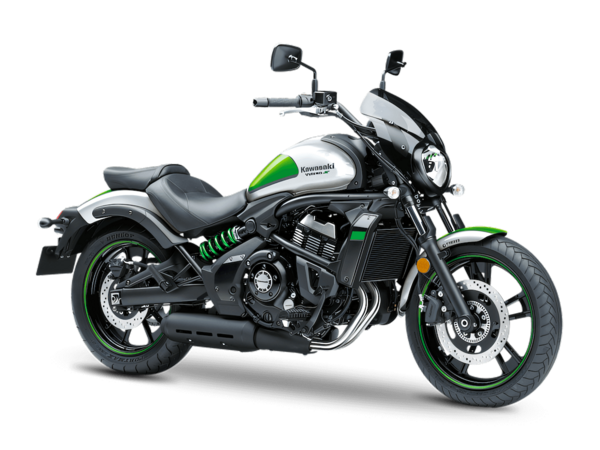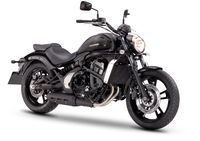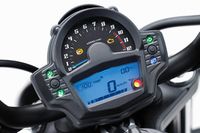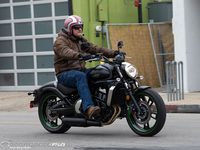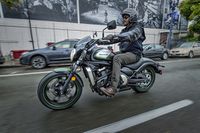Difference between revisions of "Kawasaki Vulcan S"
m |
m |
||
| Line 1: | Line 1: | ||
{{DISPLAYTITLE: Kawasaki Vulcan S (EN650S)}} | {{DISPLAYTITLE: Kawasaki Vulcan S (EN650S)}} | ||
| + | {{#seo: | ||
| + | |keywords={{PAGENAME}}, review, specs, owners manual, service manual, guide | ||
| + | |og:image= | ||
| + | }} | ||
__notoc__ | __notoc__ | ||
[[file: En650 mod3.png | 600px | center | Kawasaki Vulcan S Cafe]] | [[file: En650 mod3.png | 600px | center | Kawasaki Vulcan S Cafe]] | ||
The Kawasaki Vulcan S was first introduced in 2014 as a 2015 model. The motorcycle is the modern successor to [[Kawasaki_EN500_Vulcan | Kawasaki EN500 Vulcan]]. The model also has the name - '''Kawasaki EN650 Vulcan'''. | The Kawasaki Vulcan S was first introduced in 2014 as a 2015 model. The motorcycle is the modern successor to [[Kawasaki_EN500_Vulcan | Kawasaki EN500 Vulcan]]. The model also has the name - '''Kawasaki EN650 Vulcan'''. | ||
{{Ads_top}} | {{Ads_top}} | ||
| + | |||
| + | ''' Main competitors: ''' | ||
| + | * [[Honda_CTX700 | Honda CTX 700]] | ||
| + | |||
The motorcycle was based on the engine from [[Kawasaki_ER-6 | Kawasaki ER-6]] and [[Kawasaki_Versys_650 | Kawasaki Versys 650]], which was slightly reconfigured (the maximum power decreased, the torque characteristic increased in the low and medium speed zone) and housed in a steel diamond frame, giving an overall appearance similar to the Harley-Davidson V-rod. | The motorcycle was based on the engine from [[Kawasaki_ER-6 | Kawasaki ER-6]] and [[Kawasaki_Versys_650 | Kawasaki Versys 650]], which was slightly reconfigured (the maximum power decreased, the torque characteristic increased in the low and medium speed zone) and housed in a steel diamond frame, giving an overall appearance similar to the Harley-Davidson V-rod. | ||
| Line 14: | Line 22: | ||
In general, the concept of Kawasaki Vulcan S is to offer the market a motorcycle with a brutal appearance, reminiscent of the design of power cruisers, but in terms of equipment and character comparable to the usual modern road bikes (light weight, comfortable fit, medium-volume engine, good dynamic characteristics, economy). | In general, the concept of Kawasaki Vulcan S is to offer the market a motorcycle with a brutal appearance, reminiscent of the design of power cruisers, but in terms of equipment and character comparable to the usual modern road bikes (light weight, comfortable fit, medium-volume engine, good dynamic characteristics, economy). | ||
| − | |||
| − | |||
| − | |||
== Photos == | == Photos == | ||
Revision as of 16:26, 13 July 2023
The Kawasaki Vulcan S was first introduced in 2014 as a 2015 model. The motorcycle is the modern successor to Kawasaki EN500 Vulcan. The model also has the name - Kawasaki EN650 Vulcan.
Main competitors:
The motorcycle was based on the engine from Kawasaki ER-6 and Kawasaki Versys 650, which was slightly reconfigured (the maximum power decreased, the torque characteristic increased in the low and medium speed zone) and housed in a steel diamond frame, giving an overall appearance similar to the Harley-Davidson V-rod.
In 2017, in addition to the main version of the motorcycle, two others also appear, differing mainly only in color schemes:
- Kawasaki Vulcan S Special Edition
- Kawasaki Vulcan S Cafe
Of the features of the motorcycle, an in-line 2-cylinder engine with a volume of 649 cc should be distinguished. cm. (delivering 61 hp of power and 63 Nm of torque), steel diamond frame, disc brakes front and rear (versions with ABS), electronic fuel injection, 6-speed gearbox, chain drive to the rear wheel and fuel tank 14 liters.
In general, the concept of Kawasaki Vulcan S is to offer the market a motorcycle with a brutal appearance, reminiscent of the design of power cruisers, but in terms of equipment and character comparable to the usual modern road bikes (light weight, comfortable fit, medium-volume engine, good dynamic characteristics, economy).
Photos
Specifications
Specifications Kawasaki Vulcan S:
| Model | Kawasaki Vulcan S |
|---|---|
| Motorcycle type | cruiser |
| Release year | 2014+ |
| Frame | steel tubular |
| Engine type | 2-cylinder, 4-stroke, in-line |
| Working volume | 649 cc cm. |
| Bore / Stroke | 83.0 x 60.0 mm |
| Compression ratio | 10.8: 1 |
| Cooling | liquid |
| Number of valves per cylinder | DOHC, 4 valves per cylinder |
| Fuel supply system | injector, 2x 38 mm |
| Ignition type | transistor |
| Maximum power | 61.0 h.p. (45 kW) at 7500 rpm |
| Maximum torque | 63.0 Nm (6.4 kgf * m) @ 6600 rpm |
| Gearbox | 6-speed |
| Drive type | chain |
| Front tire size | 120 / 70R18M / C 59H |
| Rear tire size | 160 / 60R17M / C 69H |
| Front brakes | 1 disc, 300 mm, 2-piston caliper (ABS) |
| Rear brakes | 1 disc, 250 mm, 1-piston caliper (ABS) |
| Front suspension | 41mm telescopic fork, 130mm travel |
| Rear suspension | linkage Uni-trak with monoshock (7-stage preload adjustment), stroke - 80 mm |
| Motorcycle length | 2310 mm |
| Motorcycle width | 880 mm |
| Motorcycle height | 1100 mm |
| Wheelbase | 1575 mm |
| Saddle height | 705 mm |
| Acceleration to 100 km / h | 4.2 sec |
| Maximum speed | 175 km / h |
| Fuel tank capacity | 14.0 l |
| Motorcycle weight (curb) | 225 kg - Vulcan S (2015-2016)
228 kg - Vulcan S ABS (2015-2016) 229 kg - Vulcan S ABS (2017+) 231 kg - Vulcan S Cafe |
Documentation
